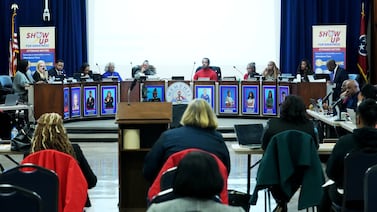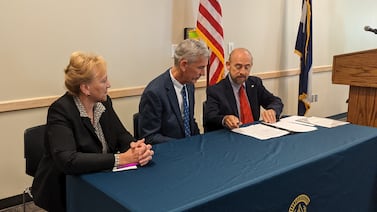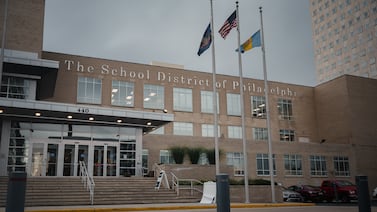Next year, Philadelphia school leaders have warned their “rightsizing” process will likely result in more school shutdowns for a city that’s still recovering from the last painful spate of closures.
School buildings in Philly are on average 73 years old and are ridden with asbestos, lead, aging electrical systems, nonoperating bathrooms, and a host of other major issues. Demographic shifts have also meant several schools in the Northeast region of the city are bursting at the seams, while others stand nearly empty.
Superintendent Tony Watlington has said reorganizing the district — and closing some buildings that are too costly to renovate — will allow resources to be spread more equally. But Watlington and city residents are haunted by the last school closure process in 2013, which negatively impacted students’ academic performance and mental health.
This time, district leaders have sworn, things will be different.
In light of the district’s promises, our partners over at Shelterforce spoke with Akira Drake Rodriguez, an assistant professor of city planning at the University of Pennsylvania, about how school closures in Philadelphia affect neighborhoods, what alternative visions could be for those schools, and how communities are starting to organize to change the way school facilities planning is done.
This interview has been edited for length and clarity. Read the full interview here.
Shelterforce Editor-in-Chief Miriam Axel-Lute: Thank you for joining me, Akira, to talk about school closures and equity. Tell us a little bit about yourself and how you got into studying this topic.
I started looking at public schools as infrastructure, whether it’s physical infrastructure or social infrastructure, in Philadelphia. We had this earlier experience in Philadelphia in 2013, where about 30 schools were closed. [I looked at] what changes to the neighborhood and the community and the built environment followed after the closures, and how to incorporate those lessons into future school facility planning processes.
You’ve said, “A good school is an open school.” Let’s look at a neighborhood and talk about what can happen when a school closes. I know you have some examples of some different ways that it happened in Philadelphia in the 2013 closures.
The 2013 closures were initiated through a private process. It could be framed as a planning process, but there was no community engagement or even a broad awareness that this was happening. The school district of Philadelphia engaged Boston Consulting Group to write a report on school facilities in the city. This looked at very technical data, such as what we call Facilities Conditions Index or FCI, which analyzes the systems of a school — plumbing, roof, electricity, etc. — estimates the condition of them, and then estimates the cost to get it into good condition.
If the cost of the repair is higher than its replacement, usually you’re going to remove that system. If enough systems need to be removed, then that translates into the closure of the school.
Another data point that they used was this idea of utilization. Philadelphia is a very old city. We had massive school construction at the turn of the 20th century and mid-century as the city is growing. It reached its peak of about 2 million residents in 1950.
We had high schools that were constructed for 2,000, 3,000 students that, by the time this planning process is happening, are serving literally 200 students. In addition to closures, a lot of the recommendations in the Boston Consulting Group report [were for] consolidation.
There were about 250 schools, and about 60 schools were [recommended] in this report for a closure or consolidation. The board, at the time, was a state-run board. The school district’s local control had been taken away by the state in 2001.
At that point, people are organizing to counteract these closures and consolidations. Some schools are saved, but are still what I consider to be vulnerable in future processes; others are closed or consolidated.
This caused some destabilization. One of the areas that was hardest hit was an area that’s on the border of one of our more affluent suburbs, the western part of our city, an area known as Overbrook, which borders Montgomery County, a very affluent county. Residents and organizers have actually done a school funding walk where they walk from Gompers Elementary in Philadelphia over to Lower Merion School. In that 1-mile walk, there is a disparity of basically 100 percent in additional funding for the suburban school student versus the one in Philadelphia.
That particular area saw a great deal of school closures and populations have continued to decline in those areas. North Philadelphia was also an area that was hard hit. Within a few years, you see the rise of school choice in these neighborhoods. A great deal of charters reappear in the wake of these closed schools.
I recall you telling me that in some of the different neighborhoods there were different effects on the housing market when their schools closed, some of them really deteriorating, some of them actually seeing some gentrification. Can you talk about the different kinds of things that might happen?
It’s funny, I’m at home right now. I live right across the street from a school that is closed. The house that I live in is my grandmother’s house that we moved into. I was actually supposed to go to this elementary school before my family moved out of Philadelphia. During 2013, this elementary, Smith Elementary, closed. The building has been converted into rental units, market rate. The playground and parking lot are about 12 single-family townhomes that average about $650,000. The house that was my grandmother’s house, [is] worth about $150,000, to give you some comparison.
There has been a lot of development in this area, which brings a lot of young couples that eventually become young families. There’s no school. This is happening further east in South Philadelphia with a school known as Southwark, which is a K-8 school.
Right across the street is a school known as Bok, which was a technical high school. It closed in 2013 and was repurposed into a bunch of different things — a maker space, a kiddie care center and gathering spot, a place that sells soccer equipment, a cafe, and at the top, a beautiful restaurant and bar.
This space has attracted a lot of families into the neighborhood. Southwark, which was never fully utilized, especially during the closures, but was not up for closure, is now overcrowded. Ironically, they lease the gym space from Bok because they don’t have room for all their activities.
In Overbrook, we see population decline and growth of school choice. In South Philly, we see a gentrification that’s happening as a result of the closure of this inefficient state good, the redevelopment of it into housing or to new uses, the attraction of a new type of resident and homeowner, and then the slow depopulation as families move away because they don’t have school options in this neighborhood.
Are there alternatives to closing underutilized schools that would preserve the public infrastructure for public good in a different way?
Sure. We had a public housing development in North Philadelphia that was demolished and redeveloped in a HOPE VI Choice Neighborhoods initiative approach. Part of that demolition included the closure of a local school. Then this school was actually purchased by the housing authority. They put a new school in. They hired teachers from the union. It’s effectively operating as a public school, drawing students from the neighborhood. Because the space was still so large, and the population was not utilizing that full space, they started leasing to other nonprofits that had connections to [the] school — after-school program for writers, different job training [programs], different public goods and services and advocacy groups. The results have been successful; they’ve been retaining teachers and students. You’re seeing above-average graduation rates and completion rates. This is how to adapt a public school and still keep it a public good.
Communities are going to change over time. We know that. It makes sense to adapt the public good in the public space to fit the community needs. That way you’re not having to lease auditorium and gymnasium space from private developers because you’ve sold your public good.
In contrast to the planning process in 2013 that led to all those school closures, Philadelphia has been working to embark on a different kind of school facilities planning process recently. Can you tell us about how that is going and how it’s different from what happened before?
Philadelphia schools were returned to local control in 2017. The school reform commission dissolved itself, and now we have a school board that is appointed by our mayor. This school board rightly understood that populations were still continuing to decline, and traditional public schools were underutilized and also in poor condition.
The planning process that began in 2019, when it was announced, said, “You can expect some closures and you can also expect some changes in our catchment areas, which determine, based on your address, where your local school is.”
Surprisingly, in 2019, the first reaction to this announcement was not from school organizers or teachers, but from real estate developers. The one or two really good K-8 schools in the city are highly advertised and signaled in real estate ads. The idea that some catchments would be redrawn was a little frightening for the real estate industry.
With this announcement, there was also the idea that there would be a public process. The consultants from the school district would form stakeholder groups by study areas, which were geographic areas containing about six or seven K-8 schools. They would produce some recommendations that would be presented to the public, adopted by the school board, and implemented in the following year. It was a pretty traditional planning process.
The study areas were very different from each other. For instance, that Overbrook area that I mentioned, where there were very few schools, and many were in bad shape and underutilized as a result of the previous closures. An area in North Philly that also had a lot of school closures, a rise in charter school options, but also a growing immigrant population, and new schools actually being constructed. And a third area in South Philadelphia, pretty close to our downtown, where populations were growing to the point where a new middle school was under discussion.
So we have one area where school closures are pretty imminent because we have a history of declining population; one area that’s growing, but is pretty marginalized within the city; and another area that is gentrified and growing, and needs new school options.
From the start, there was a lot of suspicion, obviously because of the legacy of school closures, which had really just happened six years before. If you’re a child whose school was closed in second grade, you’re in eighth grade now and facing possibly another closure. This isn’t a long time at all. People were a little upset about how the stakeholder groups were handpicked by principals. Elected officials and community planners dominated within these stakeholder groups.
Parents, teachers, and school advocates who were left out of the stakeholder groups took a few different approaches to improving the process. First, they pushed for stakeholders to hold community and public meetings to provide what they were learning to the public before the mass public meeting.
Second, communities that were not included in the first round of study areas were beginning to hold their own meetings and discuss the alternatives so they could prepare a counter-narrative when it was their turn in the facilities planning process.
Then a third group formed, drawing in a councilmember and three parent and neighborhood groups, which was focused on the idea of working across these study areas, instead of fighting about closures within a constrained geography — thinking about the resources we have across the city and how we can start to reallocate them more effectively.
Through this disruption of the school district’s planning process, we were able to insert some more participatory opportunities, such as expanding the number of meetings, and removing the idea of closures from the list of recommendations that were provided to stakeholder groups to start with.
This all sounds fairly similar to a lot of things that housing and community development groups get involved in, wanting to have more neighborhood input in a planning process.
Community quality of life was really centered in these discussions. I’m thinking about a group in the North Philadelphia, the high immigrant population area that I mentioned earlier. They were really concerned about school closures translating into gentrification. I felt that one of the most striking takeaways during these different meetings across the city was that people could draw a really straight line between a school closure and the construction of $400,000 townhomes in areas where that was not the median home value.
They saw this [process] as just a further coalition or growth machine that’s emerging between downtown and the school district. That was really a primary concern.
You also have concerns about segregation. There were parents — particularly in the growing neighborhood near the downtown, who didn’t like that there was a big racial divide across one street in Philadelphia — who said, “We’re going to build a middle school. Can we draw that catchment for the middle school across this racial divide so that we can have an integrated school and set that tone?”
These were discussions that were really thinking about “We have a lot of power in this conversation. How can we set a model for something that reflects the community’s needs?”
That makes a lot of sense. It also strikes me that they could maybe step into a conversation about school closure with some of those ideas you were talking about earlier, about other ways to use underutilized space.
Yes, the co-location is, I think, so critical. Key to why [the housing authority school is] so successful now was that thoughtfulness of “this is not just an asset to monetize and sell off to fulfill our bottom line . . . this is a key public good.”
One of the hardest things is breaking through to people who have no skin in the game of the public school. You really have to sell it as, like, “These are your tax dollars, this is what your tax dollars is going to support. You shouldn’t see a school closure as something that improves your property value. You should think about how can you improve the school and your property value at the same time.”
People don’t get upset when you close a public school, but they would get upset if you closed a public park. You have to think about them in the same way: you may not directly engage with it, but it serves a broader good and anchors your community.
This story was originally published by Shelterforce as part of their Under the Lens series, exploring the ways the educational justice and housing justice movements overlap. Sign up for their newsletter here. And if you prefer listening to the series, you can do so here.





